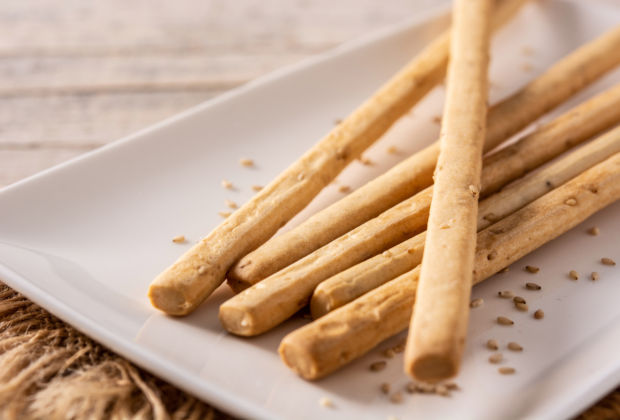Did you know that even breadsticks are a delicious gift from the city of Turin to the world?
The name “grissino” derives from the ghërsa, a type of Piedmontese bread with an elongated shape. According to legend, the invention of the first breadstick dates back to 1679, when the court baker, on the recommendation of the doctor Teobaldo Pecchio, invented this "toasted" bread to feed the very sickly future King Vittorio Amedeo II, who could not digest the crumb of the bread.
King Carlo Felice liked breadsticks so much that he even took them to the theater and munched them as a pastime.
Breadsticks quickly became popular both for their greater digestibility compared to common bread, and for the possibility of being stored for a long time without any deterioration. A great admirer of the Turin breadstick was Napoleon Bonaparte who, at the beginning of the 19th century, created a bus service between Turin and Paris mainly dedicated to the transport of what he called Les petits bâtons de Turin.
The oldest and most traditional form of breadstick is robatà, which in Piedmontese means "fallen" (or also "rolled"), of length variable from 40 to 80 cm, easily recognizable for the characteristic knotty, due to handwork.
Another traditional breadstick is the stretched breadstick. Of more recent origin than robatà, it differs from this in that the pasta, instead of being processed manually by rolling and light crushing, is stretched by stretching it from the edges to the length of the baker's arms, which gives the final product greater friability. It was above all thanks to this type of processing that the mechanized production of breadsticks was possible as early as the eighteenth century and the consequent diffusion in the world.
La storia dei grissini
Lo sapevate che anche i grissini sono un golosissimo regalo della città di Torino al mondo?
Il nome grissino deriva dalla ghërsa, un tipo di pane piemontese di forma allungata. Secondo la leggenda l’invenzione del primo grissino risalirebbe al 1679, quando il fornaio di corte, su indicazione del medico Teobaldo Pecchio, inventò questo pane “biscottato” per nutrire il cagionevolissimo futuro re Vittorio Amedeo II, che non riusciva a digerire la mollica del pane.
A Re Carlo Felice i grissini piacevano così tanto che se li portava pure a teatro e li sgranocchiava per passatempo.
I grissini divennero rapidamente popolari sia per la maggiore digeribilità rispetto al pane comune, sia per la possibilità di essere conservati a lungo senza alcun deterioramento. Grande estimatore del grissino torinese fu Napoleone Bonaparte che, all'inizio del XIX secolo, creò un servizio di corriera fra Torino e Parigi prevalentemente dedicato al trasporto di quelli che lui chiamava les petits bâtons de Turin.
La forma di grissino più antica e tradizionale è il robatà, che in piemontese significa "caduto" (o anche "rotolato"), di lunghezza variabile dai 40 agli 80 cm, facilmente riconoscibile per la caratteristica nodosità, dovuta alla lavorazione a mano.
Un altro grissino tradizionale è il grissino stirato. D'invenzione più recente rispetto al robatà, si distingue da questo in quanto la pasta, invece che essere lavorata manualmente per arrotolamento e leggero schiacciamento, viene allungata tendendola dai lembi per la lunghezza delle braccia del panificatore, il che conferisce maggiore friabilità al prodotto finale. Fu soprattutto grazie a questo tipo di lavorazione che fu possibile la produzione meccanizzata dei grissini già a partire dal XVIII secolo e la conseguente diffusione nel mondo.
Scuola Leonardo da Vinci Turin
The welcoming friendly atmosphere of our school will make you feel at home and you can relax with your classmates in the small gardens of the adjacent pedestrian area.
Latest posts by Scuola Leonardo da Vinci Turin (see all)
- The 4+1 unmissable suggestions for Christmas shopping in Turin - December 17, 2025
- What is the difference between the Carabinieri and the Police? - November 26, 2025
- 5+1 scenic spots in Turin with the Scuola Leonardo - October 15, 2025









